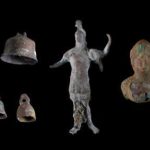Revealing the Heart of Gold: Lost Mummy Exposes Egyptian Treasures

In a remarkable discovery that has captured the imagination of archaeologists and enthusiasts alike, an ancient Egyptian mummy, long forgotten in the depths of the Egyptian Museum in Cairo, has emerged from obscurity to reveal a hidden treasure trove concealed within its bandages. Among the artifacts discovered are 49 amulets, many crafted from precious gold, offering a glimpse into the sacred rituals and beliefs of ancient Egypt.

The mummy, whose identity remains shrouded in mystery, lay undisturbed for over a century in the museum’s basement, its secrets hidden beneath layers of linen and resin. But when researchers began a comprehensive inventory of the museum’s vast collection, they stumbled upon this forgotten relic, sparking a renewed interest in its origins and significance.

In addition to the amulets, the mummy also has a garland of ferns. Dr. Sahar Saleem, the principal investigator of the study and a radiology specialist, explains that ancient Egyptians believed in the sacred and symbolic effects of plants and flowers, and they would place them next to the deceased during burial and offer them during festivals at the grave.

A revealing detail of the mummy is that it has an uncircumcised penis, a practice performed by ancient Egyptians but not Greeks. This could indicate that it belonged to royalty.
The Ptolemaic dynasty, which ruled Egypt for nearly 300 years, was of Macedonian origin, but adopted certain customs from ancient Egyptian pharaohs, although maintaining Greek practices in personal aspects like circumcision.











